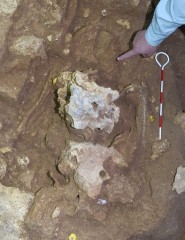domingo, 11 de enero de 2015
Human bones dating back 9,000 years found at Sakitari Cave
Vídeo YouTube por 琉球新報 el 14/12/2014 añadido a Paleo Vídeos > Prehistoria Universal > L.R.2.7 nº 47.
December 11, 2014 Ryukyu Shimpo. On December 11, an official from the Okinawa Prefectural Museum and Art museum announced that they had found human bones dating back over 9,000 years at Sakitari Cave, located in the Valley of Gangala, Maekawa in Tamagusuku, Nanjo.
The bones were found with the head and upper body connected together. According to an official of the museum, the bones were possibly put into the land as burial. He said, “This indicates the possibility that people at that time used to use caves as graves.” In Okinawa, this is the first and oldest specimen of a connected skeleton found in its original position and not relocated.
Bones from one adult individual were discovered, with mainly upper-body parts such as the skull and arms, as well as the femur and pelvis. The bones were dug from about three meters beneath an excavation site near the entrance of Sakitari Cave. The bones were found in a posture lying flat and facing up, covered by four pieces of limestone about 30 centimeters in diameter, which suggests this was a deliberate burial.
While prehistoric human bones from the Paleolithic era, about 20,000 years ago, like the Minatogawa Man and the Shiraho Saonetabaru Cavemen, have previously been discovered in Okinawa, this is the first time a specimen with a connected skeleton has been found. (English translation by T&CT and Lima Tokumori) english.ryukyushimpo.jp
Related news (January 09, 2015): Ancient burial remains in Okinawa cave may fill void in Japanese ancestry
... The bones dating to the Jomon Pottery Culture period (c. 8000 B.C.-300 B.C.) were found under 3 meters of dirt, indicating they had not been disturbed. Four large stones about 30 centimeters long had been placed over such areas as the head, chest and stomach of the adult, of undetermined gender, who was lying face-up.
As joints in the arms remained connected, it is believed the bones were found in their original site, suggesting the cave was used as a tomb.
The bones were also excavated from a depth below where earthenware about 9,000 years old was previously found, suggesting they date further back in time...
Etiquetas:
video 2
Suscribirse a:
Enviar comentarios (Atom)








No hay comentarios:
Publicar un comentario